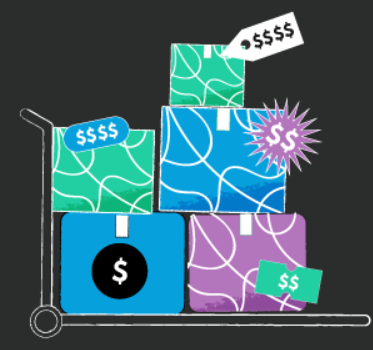
In the world of freight, we often think of it as simply trucks driving down highways. However, B2B freight is far more complex, involving various transportation methods, shipments, and intricate pricing strategies. The question is, could B2B freight providers benefit from adopting some of the customer-centric strategies commonly seen in B2C (Business-to-Consumer) shipping?
Transportation Modes in B2B Freight
When moving goods between businesses, there are several modes of transportation available. Each option is best suited for different circumstances:
- Road Transport (Trucking): This is the most versatile option, with everything from local deliveries to long-haul trucking across countries. Trucking is the backbone of B2B logistics.
- Rail Transport: Ideal for transporting bulk goods over long distances, rail is slower than trucking but very cost-effective for heavy loads like grain or coal.
- Ocean Freight: This is the go-to method for international shipments. Whether you’re importing raw materials or exporting finished products, ocean freight handles large volumes across the globe.
- Air Freight: A premium option, air freight is the fastest but also the most expensive. It’s perfect for high-value or time-sensitive goods.
Types of Shipments in B2B Freight
B2B shipments are often categorized based on size and volume:
- Full Truckload (FTL): This is when the shipment fills an entire truck, which is usually more cost-effective and faster since it’s delivered directly to the destination.
- Less than Truckload (LTL): Smaller shipments that share space with other businesses’ goods. LTL is more affordable but usually takes longer due to shared routing.
- Parcel: Smaller shipments, typically under 150 pounds, often used for urgent deliveries in B2B operations, despite being associated more with B2C logistics.
The B2B vs. B2C Freight Experience
While B2C and B2B freight share similarities, there are several key differences:
- Scale and Volume: B2C deals with individual packages, whereas B2B handles bulk shipments like pallets or truckloads. A single B2B shipment could be equivalent to thousands of B2C parcels.
- Delivery Locations: B2C shipments usually go to residential addresses with predictable delivery hours. In contrast, B2B deliveries involve more complex schedules and specific delivery windows to warehouses, factories, or distribution centers.
- Service Expectations: B2C customers expect fast, real-time tracking, while B2B customers often prioritize reliability and consistency. Many B2B clients prefer predictable schedules over faster, but inconsistent service.
- Pricing Structure: In B2C, shipping costs are relatively simple and transparent. B2B freight, however, involves many variables like fuel surcharges, lane pricing, and contract terms, making the pricing structure much more complex.
- Relationship Dynamics: B2C transactions are typically one-off, whereas B2B freight often involves long-term partnerships. Freight providers in the B2B space are seen as integral parts of a customer’s supply chain.
Could B2B Freight Providers Benefit from B2C-Style Shipping Options?
In the B2C space, consumers are accustomed to a range of shipping options, from free standard shipping to premium next-day delivery for an additional fee. This tiered approach allows customers to choose what best suits their needs—whether it’s cost or speed. B2B freight providers could adopt similar pricing structures to improve customer experience and profitability.
The Case for Tiered Freight Pricing in B2B
While B2B freight pricing is notoriously complex, it doesn’t mean that freight providers can’t borrow some concepts from B2C. In the consumer market, companies often offer multiple pricing tiers, such as:
- Standard delivery: Slow but free or inexpensive
- Expedited delivery: Faster delivery at a moderate cost
- Express delivery: Quickest delivery at a premium rate
This flexibility allows B2C customers to choose based on their preferences for cost, speed, or a balance of both. Should B2B freight adopt similar strategies? Here’s how it could work:
- Improved Cost-to-Serve: With a tiered pricing structure, companies could offer expedited or same-day deliveries for a premium, while offering cheaper, longer-lead-time options for less urgent shipments. This approach would help balance the cost-to-serve and improve margins, particularly for customers who frequently make emergency orders.
- Smoother Demand: A tiered system could reduce the unpredictability of orders. If customers can choose between slower, cheaper deliveries or faster options for an additional cost, this could help balance freight demand, smoothing out spikes and ensuring better capacity management.
- Operational Efficiency: By offering different shipping options, B2B providers can better allocate resources. When a customer opts for standard delivery, it can allow for more efficient load planning and routing.
Challenges in Adopting a Tiered System
Although a tiered pricing model has its benefits, there are challenges in applying this concept to B2B freight. The pricing structure is complex, and customization is required for each client. Freight providers are also accustomed to negotiating rates based on specific needs, and introducing tiered options could complicate this process. Furthermore, B2B businesses often have unique requirements that differ from consumer transactions, making it harder to implement a one-size-fits-all approach.
Conclusion
While B2B freight operations are complex, there’s potential for providers to draw inspiration from the B2C world’s tiered service models. By offering customers the choice between various shipping speeds and prices, B2B companies can improve cost efficiency, smooth demand spikes, and enhance customer satisfaction. However, this shift would require careful consideration of the unique needs and expectations of B2B customers, along with adjustments to the existing freight pricing structure. As supply chains evolve, embracing flexibility and offering tailored options could help businesses navigate future challenges and stay competitive.












